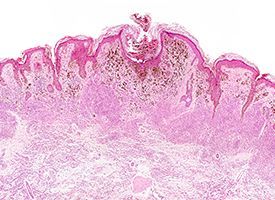Garutti Examines Advantages of Neoadjuvant Approaches in Melanoma
Mattia Garutti, MD, discusses the advantages of neoadjuvant therapy, predictive biomarkers under exploration, and future neoadjuvant clinical trial development.

The use of adjuvant therapies in melanoma could offer superior efficacy compared to what is currently provided by adjuvant therapies alone, with some preclinical data pointing to increased clinical benefit within this patient population, according to Mattia Garutti, MD.
“Especially in [patients with] stage III melanoma, the risk of relapse is really high,” said Garutti. “We need different strategies to increase cure rates for our patients. Neoadjuvant therapies in melanoma represent an exciting area of research. In other [diseases], such as breast cancer, the shift from the adjuvant to neoadjuvant therapy [has become] a gold standard. In melanoma, this shift is expected in the near future.”
Despite the advances that have been made with adjuvant therapies in recent years, patients with stage III melanoma still are at significant risk for relapse, Garutti and colleagues, wrote in a recent literature review. Neoadjuvant treatment could potentially offer superior efficacy compared with adjuvant treatment, according to the authors. By shifting focus to the neoadjuvant setting, it could be possible to reduce the need for surgery for some patients and help tailor adjuvant approaches.
“In the future, neoadjuvant therapy will change the equilibrium of therapy for [patients with] melanoma,” Garutti added. “Neoadjuvant therapies represent an opportunity for patients, but also a potential milestone for [the] melanoma treatment [paradigm].”
In an interview with OncLive, Garutti, a medical oncologist within the Unit of Clinical Oncology at FCentro di Riferimento Oncologico, discussed the advantages of neoadjuvant therapy, predictive biomarkers under exploration, and future neoadjuvant clinical trial development.
OncLive: What are the advantages of neoadjuvant therapies in patients with melanoma?
Garutti: In melanoma, [neoadjuvant therapies] have 3 major advantages compared with adjuvant therapies. First, neoadjuvant [treatments] may be superior to adjuvant strategies. [While] we still don't have a formal clinical demonstration of this hypothesis, some preclinical data [provide] some evidence. Even some trials, such as the Combi-Neo trial, suggest that neoadjuvant strategies could increase clinical benefit for patients.
The second advantage is that neoadjuvant therapy can give us surrogate outcomes such as pathological complete response (pCR) or near-pCR; that are already well-known in other diseases, such as breast cancer. In melanoma, these surrogate outcomes have correlated with increased relapse-free survival. It's an important surrogate outcome that can help guide clinicians to tailor adjuvant treatments because patients who can reach a pCR can probably avoid adjuvant treatments and maybe even avoid surgery. On the contrary, patients who don't achieve a pCR probably need an escalation of adjuvant therapy and will still require surgery.
The third advantage is that [neoadjuvant strategies] provide a very good platform to perform translational studies in order to find new biomarkers, especially predictive ones.
Could you discuss some of the current neoadjuvant approaches that you are using in clinical practice?
We have 3 different strategies with regard to neoadjuvant therapy. The first strategy, which is the most studied and is most robust in terms of data, is immunotherapy. The second is represented by targeted therapies, particularly BRAF and MEK inhibitors. The third approach, which is a bit more futuristic, is the combination of both strategies.
Of course, immunotherapy can be [given] as a single agent. We have some interesting data regarding pembrolizumab (Keytruda) or nivolumab (Opdivo) and, in general, anti–PD-1 or anti–PD-L1 agents. [We also have data with regard to] combination immunotherapies such as nivolumab plus ipilimumab (Yervoy).
There is a big difference between these 2 strategies. Single-agent approaches have shown good efficacy with a pCR and near-pCR of approximately 30%. With the combination approaches, efficacy is [even] higher, with a pCR and near-pCR rate of nearly 70%. However, it is important that this efficacy comes at a cost. The combination has more grade 3 and 4 toxicities, with nearly 50% of patients experiencing these effects.
In the future, it will be really interesting to take the data that we have seen in metastatic melanoma and [apply that to] the neoadjuvant setting. For example, talimogene laherparepvec (T-VEC; Imlygic) could be a promising agent, especially when combined with an anti–PD-1 agent. Maybe, although this would also be a bit futuristic, we could even combine this agent with an anti–CTLA-4 agent, such as ipilimumab.
You mentioned the hunt for predictive biomarkers to inform these approaches. What is some of the research that is being done in this setting?
This is a very interesting and rapidly-evolving field because in the neoadjuvant setting, we don't [currently] have any clinically useful biomarkers. However, we have several [prospective] biomarkers, in particular predictive biomarkers. I believe that in the future, this will expand sharply.
If we look at different trials, even in other types of cancer, often 1 single biomarker is not enough. Often, the combination of different biomarkers can increase the precision of these biomarkers. PD-L1, for example, could not be enough on its own. However, when this is combined with other biomarkers, such as microbiota, tumor mutational burden, interferon signature, interleukin expression, beta microglobulin, or AMHC1 or 2, the precision will increase sharply.
How do you feel future neoadjuvant trials will be shaped by the International Neoadjuvant Melanoma Consortium guidelines?
International Neoadjuvant Melanoma Consortium guidelines are a great effort to improve the quality and the standardization of neoadjuvant trials. A very important focus—and this is a little bit paradoxical—is not only the neoadjuvant treatments, but also the adjuvant treatments. We need to modulate the whole treatment [journey for our] patients.
If a pCR is reached in the neoadjuvant phase of treatment, probably de-escalation in the adjuvant phase is warranted. However, if pCR is not reached, maybe an escalation in the adjuvant phase is considerable. This topic is studied by a very interesting trial known as the PRADO trial for which we are awaiting future results.
Reference
Garutti M, Buriolla S, Bertoli E, et al. “To anticipate”: neoadjuvant therapy in melanoma with a focus on predictive biomarkers. Cancers (Basel). 2020;12(7):1941. doi:10.3390/cancers12071941



